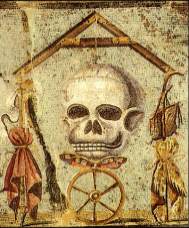Documento senza titolo
POMPEII
by Giovanni Lombardo
Habentibus symbolum facilis est transitus (Iamblicus)
In Pompeii, in the Architects' House, there is a particular mosaic, the photography of which is often shown in Masonic texts. It was the emblem in the floor of the Triclinium and man thinks that the naturalistic representation of the skull and of the mason's tools is an allegoric reference to the lapsing of the human life and the looming death. In my opinion, however, the tile conceals a deeper mean-ing. I strove to find it and I want, therefore, to share with you my thoughts.

The level measures the horizontality, being a precision tool which ensures stability and balance. It guarantees that all the hori-zontal levels are perfect and in line with that of the foundation, which will have been controlled in the same manner. The level in the illustration is a composite one, from the superior angle descends a plumb: it is worth of notice the circumstance that the horizontality is measured through the verticality – its contrary! – and this happens when the plumb has divided the ruler – which unifies the arms of the level – in two equal parts, thus forming two angles, each measuring 90°. The crossing point of the plumb and of the level is said fire line , which demarcates Time from Eternity.
The calm and smooth horizontal line of the level is quite opposite of the chaos and of the confu-sion that reign in the profane world. Even more, in the book of Isaiah, man reads: Judgment also will I lay to the line, and righteousness to the plummet (1). In this verse the level symbolizes the jus-tice since it represents the perfect union of the verticality with the horizontality.
Other thoughts are however possible, if man considers the arms of the level as two rays of a circumference departing from the “centre”, i. e. from the Being towards the Manifestation. Such an interpretation is strengthened by examining the remaining objects that are represented in the tile. A skull, then, tied to the arms of the level: the royal purple and a sceptre (at left of the observer); a sack and a stick. In the middle, under the skull, a butterfly over a six-spoked wheel.
The world of the manifestation, in that we actually live, is produced by the emanation of the One: the radiation from the centre towards the circumference. It is the kingdom of the duality, of the variety. In it, poverty and richness live together. This is the meaning of the royal purple and of the sceptre, which are symbols of the royal power and of wealth, opposite to the sack and the stick, symbols of poverty and weakness. All in perfect equilibrium.
They are aside the wheel, which is the symbol of the world. The circumference is symbol of the variety, to be considered in its perennial becoming; the rays delimit a portion of this circumference, such a portion is therefore symbol of the cyclic time, in which are alternated the various aspects of life.
The butterfly symbolizes the man's soul. In ancient Greek psyché means both butterfly and soul. The man's task consists in living with wisdom and balance and, above all, with the con-sciousness that all that appears, the mundane reality, with its contradictions, is not the “true” real-ity, the metaphysic one, the Truth in which every intellect eventually rests (2). Here is the reason for which the butterfly is over the wheel: the soul of the initiate is “superior” in respect of the profanity.
The human being who carried his life walking “in the middle”, along the ideal line between the black tiles and the white ones of the chequered pavement, at equal distance from both, that can face the death – the skull – the supreme initiation and, ascending along the plumb, outrun the fire line and eventually arrive to the edge, the Centre, the siege of the GAOTU, thus mixing with Him: “If you can distinguish a drop in the great sea – wrote Angelus Silesius – then you will also be able to distinguish my soul within the great God”.(3)
Notes
(1) Isaiah 28, 17
(2) Dante, Divine Comedy, Paradiso XXVIII, 108
(3) A. Silesio, Cherubinisches Wandersmann , cit. by A. Coomaraswamy, Time and Eternity , Italian Editor Luni 2003 pag. 119